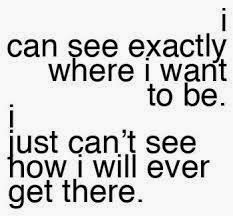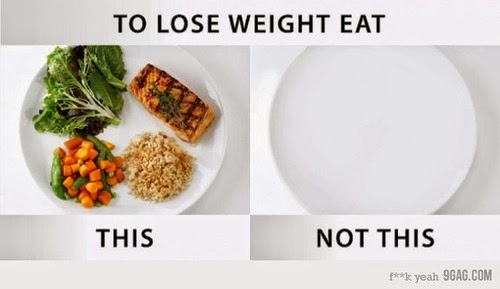I Have Lost My Way.
I’ve been lost, wandering, and floundering nutritionally and in my fitness since just before my wedding last August. Going on 6 months now. 3 months of flat-out not working out, and 3 months of trying and failing to stick with a program. Nothing has stuck. I feel lost.
This is not a new feeling for me, and I don’t like how the rest of the story goes. I know there are others, probably some people reading this, who are in the same boat – forward progress has come to a complete halt, or maybe never began in the first place. Eventually everyone will hit a plateau, or flounder, or get lost, or fall off the wagon…the trick is centering yourself and getting back on track.
Fortunately, I know how to stop this and right the ship. I’m not going to allow myself to go back over 200 lbs.
It’s time to go back to basics.
So what exactly are those “basics”? Is there some magic fix for this situation? Sure there is. Strap in, this is gonna be a doozie (the revelation AND this blog post) –
Proper Nutrition and Exercise
There, I said it. And let’s be honest – you knew I was going to. The basics: Proper Nutrition and Exercise. It kind of is magic how well it works. Eating the right amount of the right stuff will do the trick, and getting some exercise will help the process – it’s that easy and that complicated.
So where do I even begin? How do I figure out what “the right amount” and the “right stuff” is?
Step 1: What is your goal?
You have to know where you’re going before you can figure out how to get there. We’ll keep it simple right now and lump all your possible goals into three categories: do you want to gain weight (build muscle), lose weight (burn fat) or maintain (stay the same)?
Step 2: How much should I eat?
This is the deceptively hard part. How many calories do you think you should be eating? You might be shocked by the answer.
Process:
A. Figure out your BMR – B. Figure out your “Maintenance Number” – C. Figure out your target calories
Part A.) BMR is your “Basal Metabolic Rate” – it’s how many calories you burn simply existing…y’know, like, comatose. There are several formulas you can use to figure this out…I prefer the Mifflin – St. Jeor (and a recent ADA study found it to be the most accurate).
W = weight in kilograms
(weight (lbs) / 2.2) =weight in kg
H = height in centimeters
(inches x 2.54) = height in cm
A = age in years
Men
(10 x W) + (6.25 x H) – (5 x A) + 5 = BMR
Women
(10 x W) + (6.25 x H) – (5 x A) – 161 = BMR
Save this number – you’re going to need it in a minute.
Part B.) How active are you?
Some people sit at a desk all day and some people are constantly moving – how active you are VERY MUCH affects how much you should eat in a day. Multiply your BMR by whichever of the following applies to you:
BMR x 1.2 – Sedentary (Desk job – sit around a lot)
BMR x 1.3 or 1.4 – Light Activity (light activity job…walking a bit)
BMR x 1.5 or 1.6 – Moderate Activity (waitress or other “moving” job)
BMR x 1.7 or 1.8 – High Activity (physically demanding lifestyle)
BMR x 1.9, 2.0, 2.1 or 2.2 – Extreme Activity (VERY Active physicaly-engaging job/Professional Athlete)
The result is the number of calories you must eat to stay exactly where you are: your “maintenance calories”.
Part C.) Factor in your goal – lose, maintain, or gain.
Earlier, in Part A, what did you decide was your goal? Lose weight (burn fat), gain weight (build muscle mass) or maintain (stay the same)? If you said “maintain”, then the “maintenance calories” number we just figured out is your number.
If you want to lose weight: Generally, consuming 80% of your “maintenance calories” will lead you to a 1 lb/week weight loss. If you’ve got a LOT to lose, you can safely go to about 60% of your maintenance calories for a 2 lb/week loss – this is the absolute MINIMUM amount of calories you should eat.
If you eat too little you are not doing yourself any favors – your body can go into “survival mode”, afraid it will never receive food again, and store away a lot of what you give it as fat.
The absolute minimum calories you should ever eat, REGARDLESS of the above calculations, are below – NEVER go below these numbers. If your calculations try to take you lower, stop here.
1200 – women | 1500 – men
Want to GAIN weight? – Instead of subtracting 20% or 40% from your “maintenance calories”…ADD 20% or 40%. This should be roughly a 500 or 1000 calorie addition. Adding much more than that won’t result in muscle gain…just fat.
Step 3: What should I eat?
This, too, will depend on your goals. The general guideline is “eat clean” and eliminate the junk. You can try doing this in 2 stages so it’s not such a shock to the system:
Stage 1 – Avoid fried foods, fast food, and soda, limit refined (white) sugar.
Stage 2 – Eliminate white sugar & limit artificial sweeteners (raw turbinado cane sugar is ok), try to do brown/wild rice & whole grain bread/pasta instead of white. Stick to lean meats (chicken, fish, lean beef, turkey, etc).
Macro-nutrient ratios are important too! – Everything you eat is made up of 3 “macro nutrients” – Protein, Carbohydrates, & Fat. Make sure that these are balanced in the correct ratio and you’ll do a lot to help yourself. GENERALLY, for fat loss, I like to stick with 50% protein, 30% carb, 20% fat. If you’re trying to gain weight or doing some sort of athletic performance, you’ll probably need more carbs (we’ll cover macros in more detail another day).
Step 4: When should I eat?
This is really up to you, though I DO have some guidelines:
1.) ALWAYS eat breakfast
Breakfast really IS the most important meal of the day – it starts the fire and kicks your metabolism into gear. Make it count, have a couple hundred calories…take the early opportunity and throw some carbs on the fire!
 2.) The Carb/Protein sliding scale
2.) The Carb/Protein sliding scale
Short answer – Eat the majority of your carbs early in the day when your body needs the fuel for the fire, less carbs as the day goes on. More on this another day.
3.) Smaller, more frequent meals
Again, think of your metabolism like a fire – dumping a big pile of wood on the fire all at once makes it slow down and work through that big pile. If, every so often, you throw a little wood on the fire it will flare up and burn steady, shredding everything you throw at it.
4.) Spread it out
I trained myself to eat every 2 hours, and I continue that for as long as I’m awake. Think about it – the longer you’re awake – the more you’re doing – the more fuel you need. My last meal is generally 2 (maybe 3) hours before bed. Coupled with the smaller/more frequent meal idea…this is a recipe for success.
Step 5: Exercise – and eat what you burn!
Getting your nutrition in line is 80% of the battle, but exercising is important too! Exercise is a good way to (obviously) burn more calories, build some muscle, look (and feel) better, and just generally be healthier. It helps you really take charge of your health and get your fitness super-charged!
Everyone has different needs – some people don’t want to work out in a gym for whatever reason (maybe you’re not a self-starter, need constant hand-holding, and can’t afford a personal trainer 6 days a week). Some people CANNOT work out at home (distractions, lack of motivation, etc). Whatever your needs/desires, there IS an option out there for you! Maybe I can even help (and I’d be happy to!)! Regardless of the path you choose…one of the most important things to remember…
EAT THE CALORIES YOU BURN IN YOUR WORKOUT!
Yes, in order to lose weight you need to burn more calories than you take in. However…you’re already doing that by doing all that math you did earlier in this post! It is crucial that you add the calories burned in a workout to your target calories for the day.
How do you figure out how many calories you burned? Most cardio equipment can give you a good estimate or you could invest in a wearable heart rate monitor (I recommend doing that). If you’re looking for guidance/recommendations feel free to comment on this post. So what’s the bottom line here?
Exercise & Proper Nutrition Are The “Basics” That Will Make It Happen!
If you don’t see the scale move…don’t get discouraged…remember – that number isn’t the only one that means something. If you’d like a little help/guidance feel free to email me (Darrell@SoTHISIsFitness.com) or leave a comment on this post.
Disclaimer: I am not a nutritionist/registered dietitian or doctor – I have simply gone to the school of hard knocks. I have learned this through my own independent research, peer interaction, and trial/error.






